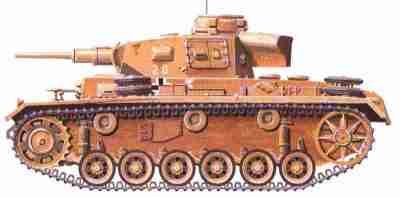Panzerkampfwagen III, SdKfz 141


The Treaty of Versailles forbade Germany to produce and design tanks. However, during the
interwar years in the late 1920s and early 1930s, the German tank industry paid close
attention to tank developments abroad, especially in Britain, France and Russia. From these
studies they concluded that two main types of battle tank were needed, one weighing about
20 tons with a high-velocity armor-piercing anti-tank gun, and the other weighing 25 tons
with a larger caliber howitzer firing high explosive shells to support infantry. After
Hitler's ascension to power and the repudiation of the Treaty of Versailles in 1935,
Germany began to rearm. Daimler-Benz and Krupp were asked to design and build prototypes
which came out in 1936 as the PzKpfw III and
PzKpfw IV
respectively. Both had a five-man
crew (commander, gunner, loader, driver and hull machine-gunner/radio operator). They had
similar features in outward appearance, except the
PzKpfw IV
was heavier and bigger.
For the PzKpfw III General Heinz Guderian wanted a 50mm gun as armament, but he and the
other proponents were overruled by the Chief of the Ordnance Office and the Inspector of
Artillery who had designated the 37mm PaK 35/36 as the standard infantry anti-tank gun.
Fortunately the designers in Daimler-Benz had the prescience to build the PzKpfw III with
a sufficiently large turret ring such that the 50mm could be accommodated in necessary.
The first in the production series was PzKpfw III Ausf A; 10 were built in mild steel for
demonstration purposes. It became quite obvious that the suspension, made up of five large
roadwheels and two return rollers each side, was not up to the task. Thus the 15 Ausf Bs
were equipped with eight small roadwheels and three return rollers. The 15 Ausf Cs and 30
Ausf Ds built incorporated further cross-country performance. The Ausf D also had increased
armor protection.
The Ausf E, which appeared in 1939, was the first definitive production model. It was
equipped with six large roadwheels on transverse torsion suspension bars, and kept the
three return rollers of the Ausf B-D. The Ausf F was the same but had some engine
improvements. The last hundred of the production run of 435 were finally armed with the
50mm KwK L/42 in 1940. The earlier Es and Fs were then retrofitted with the 50mm gun after
experience from the 1940 campaign in the West. After the French campaign 52 Ausf Es were
refitted with deep wading equipment so they could submerge to a depth of 3.96m. They were
prepared for the never-took-place planned invasion of Britain - Operation Seel�we
(Sealion). In Russia, where many river crossings were performed, these vehicles proved
their value. The 250 Ausf Ms built in 1942 were similarly equipped.
The Ausf G was originally designed to carry the 37mm gun but was hurriedly refitted. All
600 built were equipped with the larger weapon, thicker armor and more engine
modifications, and so were the 308 Ausf Hs built. The Ausf J had more armor protection
because the PzKpfw III simply could not confront the Soviet T-34s and KV-1s. The last
1,067 of the 1,549 Ausf Js produced mounted the long-barreled and more powerful 50mm KwK
L/60, as did the 653 Ausf Ls and 250 Ausf Ms. The Ausf J also had a ball mounting for the
bow machine gun. The three models, which were collectively called by the British "Mark III
Specials," were differentiated by the increasingly thinker armor. In addition, 100 of the
Ausf Ms had a flame-thrower instead of the 50mm gun.
The last production model of the PzKpfw III was the Ausf N, of which 660 were built. By
1942 the
PzKpfw IV,
which had served as infantry support tank, was refitted with
long-barreled high-velocity 75mm guns, while the PzKpfw IIIN was equipped with the
short-barreled 75mm KwK L/24 howitzer. The PzKpfw III's turret ring was too small to
absorb the size and recoil of guns more powerful than the 50mm L/60. Thus the roles of the
PzKpfw III and
IV
were reversed. In order to install the larger weapon and its larger
rounds, power traverse to the turret on the Ausf N was sacrificed, and it had to be
cranked round by hand.
The production of PzKpfw III ceased 1943 but the chassis remained in service for assault guns,
tank destroyers and self-propelled artillery pieces. In addition, command tank
(Befehlswagen) versions with dummy guns and additional radio equipment, an artillery
observation (Beobachtungswagen) version and a recovery version were produced.
Back to German Tanks Page
Back to Heer Page
Back to Homepage